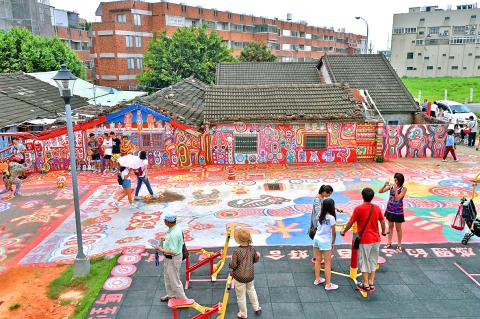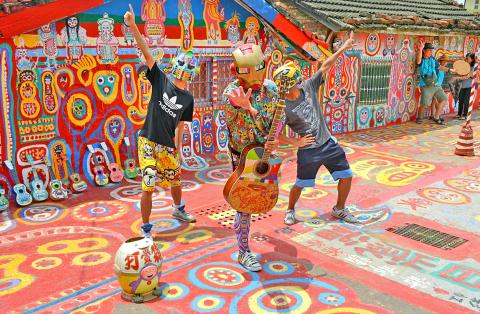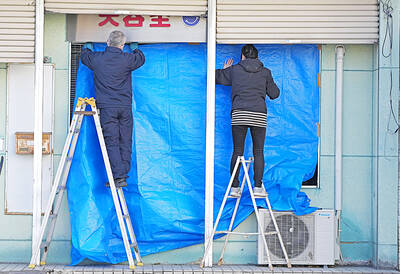Huang Yung-fu (黃永阜) greets visitors to his village in central Taiwan with paint-stained hands and shoes spattered with flecks of color, a sign of the daily artistic labor that has seen him single-handedly stave off the developers’ bulldozers.
At 93 years old, the former soldier still gets up at 3am every day to spend four hours daubing the walls of the small settlement with colorful figures, from birds and animals to celebrity singers and sportsmen.
Known as “Rainbow Grandpa,” Huang’s artwork has kept the village safe as the surrounding area has been flattened.

Photo: Sam Yeh, AFP
He walks with a slight limp and rolls up his trouser leg to reveal a bandaged knee — bruised from spending too much time kneeling on the ground to paint, he says.
However, Huang is determined to continue adding to the vibrant murals that decorate the walls and pathways of the veterans’ village or juan cun (眷村) as a way to ensure its survival.
“We had a letter five years ago saying the government wanted to knock it down to build something new. They said we could take some money or move to a different house,” said Huang, dapper in a navy flat cap and gold Chinese-style high-collared shirt. “But I didn’t want to move. This is the only real home I’ve ever known in Taiwan.”

Photo: Sam Yeh, AFP
The settlement in Taichung’s Nantun District (南屯) once comprised 1,200 homes for veterans and their families, but as the decades-old accommodation became run-down, developers snapped up the land and residents were offered NT$2 million (US$61,028 at current exchange rates) compensation or new housing.
Huang has lived there for 37 years, staying even after his neighbors abandoned their homes and only 11 houses remained. That is when he decided to paint.
“I was the only person left in the village and I was bored,” he said. “My father taught me how to paint when I was five years old, but I hadn’t done it since I was a child. “The first thing I painted was a bird inside my house.”

Photo: Sam Yeh, AFP
Huang decorated the interior of his two-bedroom bungalow, then the outer walls and the neighboring homes, which were standing empty. The ever-expanding artwork became a parade of dogs, cats, planes and his favorite celebrities, including kung fu legend Bruce Lee (李小龍).
When local university students discovered Huang’s work they launched a campaign to save the village and four years ago the authorities agreed it should be preserved. Now it is one of the area’s leading tourist attractions, pulling in more than a million visitors annually, mostly from Asia.
“The government has promised me they will keep this house and this village,” Huang said. “I was so happy and thankful.”

Photo: Sam Yeh, AFP
Officials say they are seeking to make the “Rainbow Village” a designated cultural area.
“Tourism is one of the reasons to keep it, but the main reason is that veterans’ villages are very special to Taiwan,” says Huang Ming-heng (黃名亨), chief secretary of the Taichung Cultural Affairs Bureau. “Unfortunately most of them have been knocked down, so it’s important to keep this historical memory.”
“I think they are amazing graphics — this place should be preserved,” said Hsiao Chi, 19, a student from Taipei.
“The color and the drawings are very special,” said Ivy Ng, 30, from Hong Kong, who was visiting Taichung with her family.
Originally from Hong Kong, Huang Yung-fu joined the Nationalist army in 1946 to fight Chinese Communist Party troops in China during the Chinese Civil War.
When the Chinese Nationalist Party (KMT) was defeated in 1949, many troops followed its leader, Chiang Kai-shek (蔣介石), as he fled to Taiwan. They were given temporary housing in hundreds of dedicated military villages across the island — which became permanent over the years.
The Ministry of National Defense says many of the villages have been knocked down because residents wanted better living conditions, but some bemoan the loss of the old communities.
“When they move out, people feel isolated,” said Kang Han-ming, a former marine who manages the thriving Rainbow Village business and campaigns to protect the remaining settlements. “They feel they have no roots. That’s why a lot of older veterans who move to new buildings get sick.”
The ministry has now pledged to preserve the last 13 villages as cultural areas.
Huang Yung-fu says he never tires of the early morning regime that served to save his home — a bungalow crammed with paints, marker pens and memorabilia.
The Rainbow Grandpa sits back on a chair in the shade and watches the crowds.
“I like speaking with them and they tell me the paintings are beautiful. I’ll never get lonely with all these visitors,” he said.

Taiwanese were praised for their composure after a video filmed by Taiwanese tourists capturing the moment a magnitude 7.5 earthquake struck Japan’s Aomori Prefecture went viral on social media. The video shows a hotel room shaking violently amid Monday’s quake, with objects falling to the ground. Two Taiwanese began filming with their mobile phones, while two others held the sides of a TV to prevent it from falling. When the shaking stopped, the pair calmly took down the TV and laid it flat on a tatami mat, the video shows. The video also captured the group talking about the safety of their companions bathing

US climber Alex Honnold is to attempt to scale Taipei 101 without a rope and harness in a live Netflix special on Jan. 24, the streaming platform announced on Wednesday. Accounting for the time difference, the two-hour broadcast of Honnold’s climb, called Skyscraper Live, is to air on Jan. 23 in the US, Netflix said in a statement. Honnold, 40, was the first person ever to free solo climb the 900m El Capitan rock formation in Yosemite National Park — a feat that was recorded and later made into the 2018 documentary film Free Solo. Netflix previewed Skyscraper Live in October, after videos

Starting on Jan. 1, YouBike riders must have insurance to use the service, and a six-month trial of NT$5 coupons under certain conditions would be implemented to balance bike shortages, a joint statement from transportation departments across Taipei, New Taipei City and Taoyuan announced yesterday. The rental bike system operator said that coupons would be offered to riders to rent bikes from full stations, for riders who take out an electric-assisted bike from a full station, and for riders who return a bike to an empty station. All riders with YouBike accounts are automatically eligible for the program, and each membership account

A classified Pentagon-produced, multiyear assessment — the Overmatch brief — highlighted unreported Chinese capabilities to destroy US military assets and identified US supply chain choke points, painting a disturbing picture of waning US military might, a New York Times editorial published on Monday said. US Secretary of Defense Pete Hegseth’s comments in November last year that “we lose every time” in Pentagon-conducted war games pitting the US against China further highlighted the uncertainty about the US’ capability to intervene in the event of a Chinese invasion of Taiwan. “It shows the Pentagon’s overreliance on expensive, vulnerable weapons as adversaries field cheap, technologically